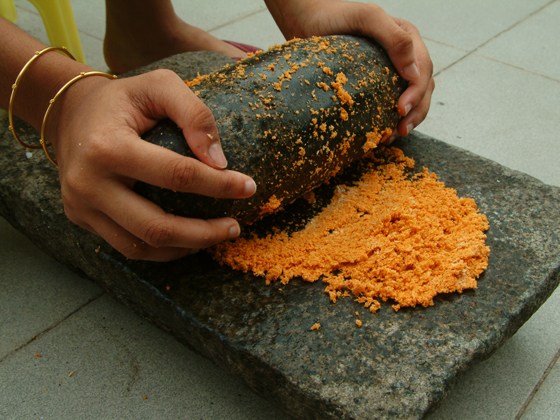Sri Lankan cuisine is spicy and varied.
A huge variety of dishes, introduced and influenced over the centuries by travelers, invaders and colonists, bring a sophistication of flavours to the table in a rich diversity of cooking styles and techniques. Sri Lankan banquets are incredibly colourful, with curries that range from yellow to deep brown, the vibrant greens of the vegetables, and the bright colours of sambol.
The central feature of Sri Lankan cuisine is boiled or steamed rice, served with a curry of fish, chicken or mutton, along with other curries made with vegetables, lentils, or fruits. Dishes are accompanied by pickled fruits or vegetables, chutneys, and sambols. Coconut sambol is especially common, a paste of ground coconut mixed with chili peppers, dried Maldive fish, and lime juice.
Regional variations are common and different ethnic and religious groups prepare dishes according to their own heritage, but coconut milk and Sri Lanka’s renowned spices are characteristic of all the island’s cuisine.
The original aboriginal hunter gatherers, the Vedda who lived in caves in Horton Plains from approx. 15,000 BC, burnt trees in order to catch game. The discovery of oats and barley also suggest that the community may have used the land for agricultural purposes. Their diet included deer, wild boar and reptiles as confirmed by the discovery of these bones at various sites. The meat was probably roasted over open fires. With the sea nearby, the inhabitants would have also eaten plenty of fish.
A rich and fertile legacy
The Sinhalese migrated to Sri Lanka probably from north India around 5000 BC and settled alongside rivers and records indicate that they enjoyed a similar diet. Excavations reveal the cultivation of wet rice was common. The Sinhalese constructed an elaborate irrigation system for times of drought and by 900 BC the use of iron and advanced forms of farming and livestock breeding were being followed. Cinnamon, which is native to Sri Lanka, was in use in Ancient Egypt in about 1500 BC, suggesting that there were trading links with the island at that time.
The island’s location made it a popular stop-off point for foreign traders, especially as it produced many fine spices such as cinnamon and cloves. Examples of foreign influence include the Arabs who introduced the use of saffron and rose water.
The first colonials, the Portuguese who ruled the island in the 1500s, introduced the use of chillies and varied culinary terms such as ‘temper’ which is derived from the Portuguese word, temperado, which is to fry and season.
The Dutch who followed introduced recipes such as Breudher, Christmas cake, Frikkadels (meatballs) and Lomprijst (rice and accompaniments wrapped in banana leaves) or Lamprais as they are known locally.
A Malay influence can be found in the rice dishes Pulao and Biryani dish. Wattalapam, which is a steamed dessert, is also a Malay dish.
